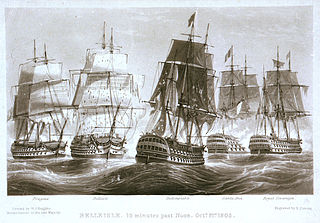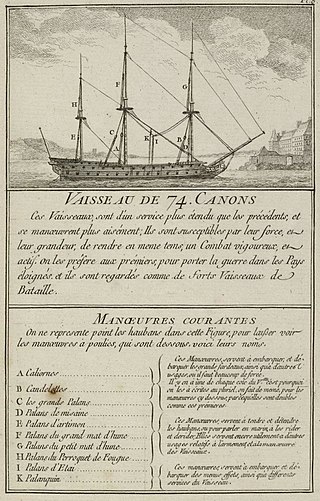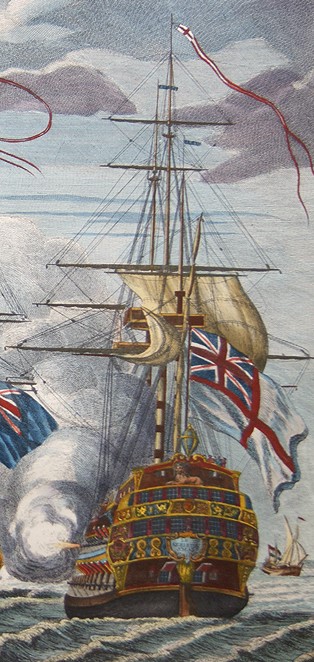
Vice-Admiral Sir John Lockhart-Ross, 6th Baronet, known as John Lockhart from 1721 to 1760, was an officer of the Royal Navy who saw service during the War of the Austrian Succession, Seven Years' War, and the American War of Independence, and served for a time as a Member of Parliament.

HMS Tonnant was an 80-gun ship of the line of the Royal Navy. She had previously been Tonnant of the French Navy and the lead ship of the Tonnant class. The British captured her in August 1793 during the Siege of Toulon but the French recaptured her when the siege was broken in December. Rear-Admiral Horatio Nelson captured her at Aboukir Bay off the coast of Egypt at the Battle of the Nile on 1 August 1798. She was taken into British service as HMS Tonnant. She went on to fight at the Battle of Trafalgar in 1805, during the Napoleonic Wars.

HMS Royal George was a ship of the line of the Royal Navy. A first-rate with 100 guns on three decks, she was the largest warship in the world at the time of her launch on 18 February 1756. Construction at Woolwich Dockyard had taken ten years.

In the Battle of Cape Finisterre off Galicia, Spain, the British fleet under Admiral Robert Calder fought an indecisive naval battle against the combined Franco-Spanish fleet which was returning from the West Indies. Failing to prevent the joining of French Admiral Pierre de Villeneuve's fleet to the squadron of Ferrol and to strike the shattering blow that would have freed Great Britain from the danger of an invasion, Calder was later court-martialled and severely reprimanded for his failure and for avoiding the renewal of the engagement on 23 and 24 July. At the same time, in the aftermath Villeneuve elected not to continue on to Brest, where his fleet could have joined with other French ships to clear the English Channel for an invasion of Great Britain.

The second battle of Cape Finisterre was a naval encounter fought during the War of the Austrian Succession on 25 October 1747 (N.S.). A British fleet of fourteen ships of the line commanded by Rear-Admiral Edward Hawke intercepted a French convoy of 250 merchant ships, sailing from the Basque Roads in western France to the West Indies and protected by eight ships of the line commanded by Vice Admiral Henri-François des Herbiers.

Formidable was an 80-gun Tonnant-class ship of the line of the French Navy, laid down in August 1794 and given the name Formidable, on 5 October, but renamed Figuieres on 4 December 1794, although the name was restored to Formidable on 31 May 1795 after she was launched at Toulon on 17 March 1795. She participated in the Battle of Algeciras, the Battle of Cape Finisterre and several other actions before the British captured her at the Battle of Cape Ortegal on 4 November 1805. The British took her into service as HMS Brave. She was sold to be broken up in April 1816.

Scipion was a 74-gun French ship of the line, built at Lorient to a design by Jacques Noel Sane. She was laid down as Orient in late 1798, and renamed Scipion in 1801. She was first commissioned in 1802 and joined the French Mediterranean fleet based at Toulon, in the squadron of Admiral Leissègues. Consequently, she was one of the ships afloat in that port when war with England reopened in May 1803. She participated in the Battle of Cape Finisterre and the Battle of Trafalgar. The British captured her in the subsequent Battle of Cape Ortegal. In 1810 she participated in the Java campaign, which in 1847 earned her surviving crew the Naval General Service Medal. She participated in the blockade of Toulon in 1813 and was paid off in 1814. She was broken up in 1819.

Julien Marie Cosmao-Kerjulien was a French Navy officer, admiral, best remembered for his role in the Battle of Trafalgar.

Indomptable ("Indomitable") was a Tonnant-class 80-gun ship of the line in the French Navy, laid down in 1788 and in active service from 1791. Engaged against the Royal Navy after 1794, she was damaged in the Battle of Trafalgar and wrecked near the Spanish city of Cadiz on 25/26 October 1805.

HMS Berwick was a 74-gun Elizabeth-class third rate of the Royal Navy, launched at Portsmouth Dockyard on 18 April 1775, to a design by Sir Thomas Slade. She fought the French at the Battle of Ushant (1778) and the Dutch at the Battle of Dogger Bank (1781). The French captured her in the action of 8 March 1795 during the French Revolutionary Wars and she served with them with some success then and at the start of the Napoleonic Wars until the British recaptured her at the Battle of Trafalgar. Berwick sank shortly thereafter in a storm.
Vice-Admiral Sir Peter Denis, 1st Baronet was an English naval officer and Member of Parliament.

HMS Alcide, the French and Italian version of "Alcides", another name for Heracles, was a 74-gun third-rate ship of the line of the Royal Navy, designed by Sir Thomas Slade and built by Adam Hayes at Deptford Dockyard being launched on 30 July 1779.
HMS Alfred was a 74-gun third rate ship of the line of the Royal Navy, launched on 22 October 1778 at Chatham Dockyard.

HMS Kent was a 70-gun third rate ship of the line built by Sir Henry Johnson of Blackwall in 1677/79. She served during the War of English Succession 1699 to 1697, participating in the Battle of Barfleur. She was rebuilt in 1697/99. She served during the War of Spanish Succession 1702 to 1712 and partook in the Battles of Vigo and Velez-Malaga. She partook in the Battle of Passaro then served during the short war with Spain, December 1718 to February 1720. She was rebuilt in 1722/26. She spent the next thirteen years as a guard ship at Portsmouth. In the 1740s she was off Cape Finisterre then in the West Indies. She returned home and was finally broken in 1744.
Vice-Admiral Sir Patrick Campbell, KCB was a senior British Royal Navy officer of the early nineteenth century who was distinguished by his service in the French Revolutionary and Napoleonic Wars. During his service in a number of ships in the Mediterranean and English Channel, Campbell saw several small ship actions and was successful in every one, even surviving a double shipwreck in 1805. Following the war, Campbell retired for ten years before returning to service, later commanding at the Cape of Good Hope.

Charles René Magon de Médine was a French contre-amiral killed at the battle of Trafalgar whilst commanding the ship-of-the-line Algésiras - his conduct in the battle is seen by French historians as one of the few redeeming features of that disaster, and his name appears on the Arc de Triomphe. He is also notable as a Grand Officer of the Masonic Grand Orient de France.

Le Magnanime was originally a 74-gun ship of the line of the French Navy launched in 1744 at Rochefort. Captured on 12 January 1748, she was taken into Royal Navy service as the third rate HMS Magnanime. She played a major part in the 1757 Rochefort expedition, helping to silence the batteries on the Isle of Aix, and served at the Battle of Quiberon Bay in 1759 under Lord Howe, where she forced the surrender of the French 74-gun Héros. Following a survey in 1770, she was deemed unseaworthy and was broken up in 1775.

Intrépide was a 74-gun ship of the line of the French Navy. She was of three ships of the Monarque class, all launched in 1747, the others being Monarque and Sceptre.

HMS Intrepid was a 64-gun third rate ship of the line of the Royal Navy, originally built in Toulon for the French Navy. She was launched in 1740, as Sérieux and fought at the Battle of Toulon before her capture by the British at the First Battle of Cape Finisterre in 1747. After being renamed and refitted by the Royal Navy, she entered British service in late 1747. Between 1748 and 1752 she was assigned as a guard ship off the coast of Kent in south-east England.

















